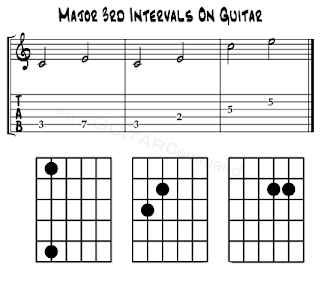Playing Thirds Up and Down Your Guitar Neck...
Learn how to control your two-note chord sound by mastering the most popular interval in western music - the third interval...
Many genres and guitar styles in American music are based on the all-important interval of a third. Melodies and solo lines are often constructed using thirds, and chord structures (for example, triads, and seventh chords) are built in thirds (sometimes known as tertian or tertial harmony). The type of third interval—major or minor—will determine the characteristic sound of the chord, whereas fifths and sevenths do not have the same degree of influence.
In this post, you’ll learn different ways to map out and play thirds all over the fretboard. Lines based on thirds present great material for picking- and fretting-hand exercises, and also provide a solid foundation for melodic ideas and solos to explore in your improvising and writing (scroll down to view the music examples).
There are two types of thirds intervals: major and minor. A major third is the distance of two whole steps.
MAJOR 3rd's ON GUITAR:
A minor third is smaller, and equal to a whole step, plus a half step. Thirds can be played on the same string or on adjacent strings. It’s important to hear, as well as see and feel, the differences between major and minor thirds.
MINOR 3rd's ON GUITAR:
In these examples, C is the root; the "Eb" tone is the minor third, (a step and a 1/2 above C), and the "E" natural is the major third (two whole steps above C).
However, these relationships are the same with any root, and they will look and feel the same on all adjacent strings, except for the 3rd and 2nd strings. This is due to the guitar’s standard tuning.
#1). HARMONIZED 3rd's EXERCISE: (Strings 2 and 1)
This key of "D Major" harmonized drill works across the top two strings and applies the diatonic harmony of the keys 3rd's along the range of the entire fingerboard. Keep in mind that all of these shapes will also work for the key's relative Minor "B Minor."
#2). HARMONIZED 3rd's EXERCISE: (Strings 3 and 2)
This exercise works across the 3rd and 2nd strings to produce a harmony of thirds in the key of "A Major." Since the tuning is different on these two string sets the shapes for the two note chords will change.
#3). HARMONIZED 3rd's EXERCISE: (Strings 4 and 3)
Taking the thirds harmony over to the 4th and 3rd strings reverts us back to the original shapes that we used in exercise #1. Since the tuning interval of the strings is the same (a 4th interval) our diatonic shapes for all of the lower register strings also remains the same. In other words, the pattern we are using here (to create this 4th string root thirds run in "E Major"), would also work the same off of the 5th and 6th strings.
Play these exercises very slowly, concentrating on clarity with every note. Start out by using fingers only, and then try using strict "Hybrid" picking, (continue this as you move across the different strings).
Memorize and master one exercise before moving onto the next. Move on next to explore and map out double-stop ideas for all different types of chords so that you can effortlessly drop them in and out of a single-note solo.
Lastly, practice learning how to create several of your own melodic lines and patterns using the ideas in this lesson. Make sure to either write them down or record them so you don’t forget how they go. Eventually, you'll be able to drop them into a guitar solo anytime you wish.
___________________________________________________
GET GOOD NOW - JOIN THE MEMBERS AREA












